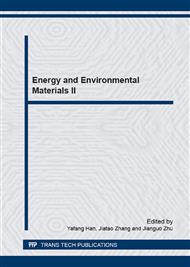[1]
B.Q. Sun, Progress in China's Beneficiation Technology for Complex Refractory Iron Ore, Chinese Journal of Metal Mine. 3 (2006) 11-13.
Google Scholar
[2]
H. Zhong, J. Xie and Z.T. Yang, Present Situation of Biomass and Gasification Technology and Its Development, Chinese Journal of Yunnan Normal University. 21 (2001) 41-45.
Google Scholar
[3]
Williams P T, Home PA, Development of biomass energy, Renewable Energy. 4 (1994) 1-13.
Google Scholar
[4]
M. Zhang, Y.C. Yuan and Y.Z. Liu, Research on biomass waste combustion technologies, Energy Research and Information. 21 (2005) 15-16.
Google Scholar
[5]
Y. Wu, Y.H. Li, X. Yang and Z.Y. Bao, The reduction mechanism of biomass roasting of goethite ores, Advanced Materials Research. 560-561 (2012) 441-446.
DOI: 10.4028/www.scientific.net/amr.560-561.441
Google Scholar
[6]
Y. Wu, M. Fang, L.D. Lan and Z.Y. Bao, Rapid and direct magnetization of goethite ore roasted by biomass fuel, Separation and Purification Technology. 94 (2012) 34-38.
DOI: 10.1016/j.seppur.2012.04.008
Google Scholar
[7]
Y. Wu, X. Yang, Y.H. Li and Z.Y. Bao, Biomass reduction roasting of goethite ore at low temperature, 26th International Mineral Pr℃essing Congress, IMPC 2012: Innovative Pr℃essing for Sustainable Growth - Conference Pr℃eedings. (2012) 5848-5853.
Google Scholar
[8]
G.S. Liu, V. Strezov, J.A. Lucas and L.J. Wibberley, Thermal investigations of direct iron ore reduction with coal, Therm℃himica Acta. 410 (2004) 133-140.
DOI: 10.1016/s0040-6031(03)00398-8
Google Scholar
[9]
S. Luo, C. Yi and Y. Zhou, Direct reduction of mixed biomass-Fe2O3 briquettes using biomass-generated syngas, Renewable Energy, 36 (2011) 3332-3336.
DOI: 10.1016/j.renene.2011.05.006
Google Scholar
[10]
K. Przepiera, A. Przepiera, Kinetics of thermal transformations of precipitated magnetite and goethite, Thermal Analysis and Calorimetry. 65 (2001) 497-503.
DOI: 10.1023/a:1012441421955
Google Scholar
[11]
Y.B. Wang, G.C. Zhu and R.A. Chi, An investigation on reduction and magnetization of limonite using biomass, Chinese Journal of Pr℃ess Engineering. 6 (2009) 508-513.
Google Scholar
[12]
Black metal ore beneficiation team, Ferrous Metal Ore Beneficiation Experiment, Metallurgy Industry Press, Beijing, (1978).
Google Scholar
[13]
X.G. Huang, Steel Metallurgy Principle, third ed., Metallurgy Industry Press, Beijing, (2007).
Google Scholar
[14]
Y. Kashiwaya, T. Akiyama, Nan℃rack formation in hematite through the dehydration of goethite and the carbon infiltration from biotar, Journal of Nanomaterials. 2010 (2010) 1-12.
DOI: 10.1155/2010/235609
Google Scholar
[15]
K. Hanedaand, A.H. Morrish, Magnetite to maghemite transformation in ultrafine particles, Journal de Physique. 38 (1977) 321-323.
DOI: 10.1051/jphyscol:1977166
Google Scholar
[16]
F. Adam, B. Dupre, C. Gleitzer, Cracking of hematite crystals during their low-temperature reduction into magnetite, Solid State Ionics. 32-33 (1989) 330-333.
DOI: 10.1016/0167-2738(89)90237-3
Google Scholar


